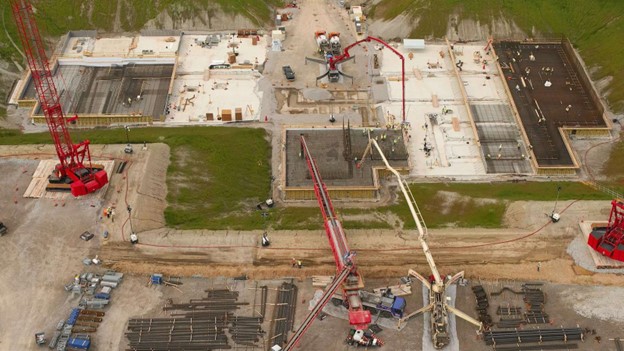Initially hailed as a symbol of U.S. chip independence, TSMC’s $40 billion Arizona project has seen numerous delays.
Production at the first factory has been pushed back to 2025 due to a lack of local expertise, while the second factory’s launch is now expected in 2027-2028, citing tech choices and funding uncertainty.
Intel’s $20 billion Ohio project has also seen delays, with chip production now expected in late 2026, partly due to market challenges and slow government grant disbursement.

1 Intel’s plant in Ohio
Despite receiving CHIPS Act funding, Microchip has announced factory shutdowns due to a sales slump, indicating the current market volatility.
Micron’s project in the U.S., a memory chip facility planned for Virginia, hasn’t escaped the common hurdles. While progress is ongoing, securing permits and navigating regulations, like other companies, continues to slow construction.
The CHIPS Act authorized grants and other incentives to boost U.S. chip production, plus tax credits for investments in factories and manufacturing equipment. More than 600 companies and organizations have expressed interest in the grants, according to the U.S. Department of Commerce, while it estimates pledges of private investment so far at $235 billion.
Market fluctuations and strategic reassessments
The initial impetus for increased U.S. chip production stemmed from the pandemic-induced surge in demand — followed by a severe shortage of chips — leading to ambitious expansion plans by major players such as Intel and TSMC. However, the current market downturn has forced a recalibration of strategies. Companies are re-evaluating investments, delaying production schedules, and prioritizing profitability in the face of uncertain demand. This cautious approach, while prudent in the short term, could potentially hinder long-term capacity building.
This boom-bust cycle is not unusual in the semiconductor industry, and the multiyear chip shortage prompted major OEMs and EMS providers to order chips more than 60 weeks in advance. Now that semiconductor demand has cooled, the electronics supply chain finds itself with an excess of chip inventory and dozens of new fab announcements that were made during the height of the shortage. Many of these fabs will produce technically advanced semiconductors while others are intended to reduce the chip industry’s dependence on China as a manufacturing, packaging and materials center.
Intel’s Ohio chip plant construction, initially aiming for production in 2025, faces significant headwinds. While market fluctuations have led to cautious investment strategies, concerns about labor availability, regulatory hurdles, and slow government funding pose additional challenges. Although construction began and Intel maintains its commitment, achieving the original production goal now seems unlikely, with estimates ranging from late 2026 to typical 3- to 5-year construction timelines for such facilities.
“Much has changed: geopolitical challenges have become greater, semiconductor demand has declined, and inflation and recessionary pressures are disrupting the global economy,” said Keyvan Esfarjani, executive vice president and chief of global operations at Intel. “We must acknowledge the abrupt change in the environment while investing to help rebalance the global silicon supply and prepare for the future.”

President Joe Biden and Intel’s Pat Gelsinger at last year’s Ohio groundbreaking ceremony.
Labor landscape and workforce development
Concerns regarding workforce availability, particularly in emerging fabrication hubs like Ohio and Arizona, have emerged as a significant obstacle. The specialized skill sets required for fab construction and operation may only be readily available in some regions, necessitating targeted training programs and talent acquisition strategies.
Additionally, navigating labor relations with unions and ensuring fair wages remain crucial components of a sustainable approach.
In Arizona, construction of the TSMC factories was expected to generate 21,000 construction jobs, with the workforce at the facilities estimated at 4,500 and thousands of additional jobs at suppliers in the area.
Last year, accusations of safety violations, labor disputes, and delays raised questions about the project’s feasibility and impact on U.S. chip production ambitions.
While TSMC attributed delays to market uncertainties and workforce challenges, insiders paint a picture of disorganization and mismanagement. Complaints range from frequent plan changes and unclear instructions to poor communication and coordination between Taiwanese contractors and local workers.
Last year’s Arizona Pipe Trades 469 Union’s petition against TSMC’s application for 500 Taiwanese worker visas highlights the tension between unions and the company. While TSMC claimed these specialists are essential for a critical construction phase, unions viewed it as an attempt to undermine American jobs and undercut wages.
“Arizona workers are getting the boot in favor of cheap labor, taking a major toll on American workers and their families. TSMC claims that Arizona workers lack experience and skills, and that’s why they need temporary workers to ‘train’ Arizona workers,” said Aaron Butler, President of the Arizona Building and Construction Trades Council. “Yet, there’s been no communication with contractors about the types of training these temporary workers will provide and how the training will be handled. The truth is our workers are well-equipped and able to meet semiconductor demands right now.”
Financial incentives
Despite the CHIPS Act’s $52.7 billion in incentives, delays in funding disbursement add another layer of uncertainty. The project’s significance goes beyond economics, as it aims to reduce U.S. reliance on imported chips, particularly from China, and strengthen national security. However, the current challenges raise questions about whether the project will deliver on its promises and contribute meaningfully to U.S. chip independence.
Navigating this complex landscape requires addressing all stakeholders’ concerns. Streamlining communication and planning, adhering to regulations, and swiftly resolving labor disputes are crucial for regaining trust and expediting construction. The U.S. government must ensure timely funding and create a regulatory environment fostering collaboration and innovation. Only through such concerted efforts can the CHIPS Act fulfill its potential and contribute to a secure and robust U.S. chip industry.
▼▼▼
AEM reports $20.9 million in losses for 2HFY2023; no bonus for management
Chinese chip maker cleared of spying charges in US criminal trade secrets case
Intel teases 1.4nm advanced manufacturing node
Apple suppliers need 103,000 workers in Vietnam this year
Japan's $67 Billion Bet to Regain Title of Global Chip Powerhouse
+86 191 9627 2716
+86 181 7379 0595
8:30 a.m. to 5:30 p.m., Monday to Friday
